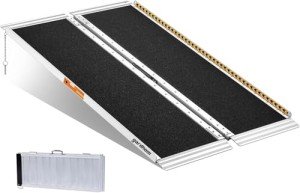This company has no active jobs
20 Tips To Help You Be More Efficient With Wheelchair Ramps
Portable Wheelchair Ramps for Steps: A Comprehensive Guide
Navigating the world can be a difficulty for people with mobility concerns, particularly when coming across stairs. Standard stairs can position substantial barriers, but portable wheelchair ramps are a flexible and practical option that can assist individuals restore their self-reliance and freedom. This article uses a thorough look at portable wheelchair ramps, including their types, advantages, considerations when choosing one, and responses to frequently asked concerns.
Comprehending Portable Wheelchair Ramps
Portable Ramps For Steps wheelchair ramps are developed to provide a smooth transition from one level to another, such as from ground to a patio or between floors in a structure. They can be easily transported and established, making them perfect for temporary use, travel, or in scenarios where a long-term ramp installation is not feasible.
Types of Portable Wheelchair Ramps
Before choosing a portable wheelchair ramp, it's necessary to understand the different types offered on the market. The choice of ramp often depends upon specific requirements, the environment, and the individual's mobility gadget. Below is a table laying out the most common types of portable wheelchair ramps.
Ramp TypeDescriptionPerfect Use CasesFolding RampsLightweight and foldable for easy transport.Home use, travel, eventsTelescoping RampsAdjustable length enabling modification of the slope.Differed heights, such as steps, curbsStrong Wheel Chair RampsMade from resilient materials and provides a steady entry.Permanent or semi-permanent installationsSuitcase RampsFold in half and resemble a suitcase when closed.Travel, outdoor occasionsLimit RampsSmall ramps designed to bridge the gap between different surfaces.Doorways, shifts from surface areasBenefits of Portable Wheelchair Ramps
The accessibility of portable wheelchair ramps has changed how individuals with restricted mobility navigate environments. Below is a list of the different advantages related to utilizing these ramps:
Accessibility: Ramps offer access to locations with steps where wheelchair users would otherwise be unable to go.
Independence: With a portable ramp, users can go into and exit buildings and cars without external support.
Flexibility: Ideal for various settings, consisting of home environments, outside areas, and public venues.
Reduce of Use: Many ramps are lightweight and simple to establish, making them user-friendly for individuals and caregivers alike.
Cost-effectiveness: Portable Wheel Chair Ramps typically come at a portion of the price of permanent installations and can be recycled in different areas.
Safety: Ramps minimize the threat of falls and mishaps associated with steering up and down steps.
Considerations When Selecting a Portable Wheelchair Ramp
Picking the ideal portable wheelchair ramp needs careful factor to consider of numerous elements. Here are some crucial points to keep in mind:
Weight Capacity: Ensure that the ramp can support the weight of the wheelchair Ramps for steps and its resident. Many ramps specify an optimum weight limit.
Length and incline: A longer ramp provides a gentler slope, which is easier to browse. Ideally, the ramp length ought to be 1:12 for ADA compliance, implying one inch of increase per foot of ramp.
Material: Ramps can be made from aluminum, fiberglass, or wood. Aluminum ramps are the most commonly utilized due to their light weight and toughness.
Portability: Look for ramps that can be quickly folded or collapsed for transport.
Surface area Texture: Ensures traction and avoids slipping, particularly in wet conditions. Grasped or textured surfaces are more suitable.
Ease of Setup: Consider ramps that do not require tools or complex assembly procedures.
Regularly Asked Questions (FAQ)
1. How do I identify the ideal ramp length?
As a general rule, a ramp should have a slope ratio of 1:12. This indicates for every inch of height, you will require a minimum of 12 inches (or 1 foot) of ramp length.
2. Are portable wheelchair ramps ADA-compliant?
It depends on the particular ramp design and dimensions. Always inspect if the ramp meets the Americans with Disabilities Act (ADA) requirements, especially for public use.
3. Can I use a portable ramp outdoors?
Yes, numerous portable ramps are created for outside usage and are made from weather-resistant products. Constantly examine the specs to confirm.
4. How do I keep a portable wheelchair ramp?
Keep the ramp clean and inspect for damage routinely. Test the surface for wear and guarantee that it remains steady during usage.
5. Can wheelchair ramps be used for other mobility gadgets?
Yes, portable ramps can accommodate different mobility gadgets, including scooters, walkers, and power chairs.

6. Where can I purchase portable wheelchair ramps?
Portable wheelchair ramps can be purchased from medical supply shops, online merchants, and specialty mobility devices suppliers.
Portable wheelchair ramps bridge the space between mobility obstacles and accessibility, making it possible for individuals with impairments to lead independent and fulfilling lives. With a variety of choices and a host of advantages, discovering the right ramp needs thoughtful consideration of the user's distinct requirements. By understanding the benefits, functions, and factors to think about, people and caregivers can make educated decisions to boost mobility and availability. Whether for use in the house, on the roadway, or in public areas, portable wheelchair ramps are vital tools that open up the world to those who need them.

